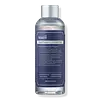What's inside
What's inside
 Key Ingredients
Key Ingredients

 Benefits
Benefits

 Concerns
Concerns

No concerns
 Ingredients Side-by-side
Ingredients Side-by-side

Water
Skin ConditioningButylene Glycol
HumectantDimethyl Sulfone
SolventBetaine
HumectantCaprylic/Capric Triglyceride
MaskingNatto Gum
Sodium Hyaluronate
HumectantDisodium EDTA
Centella Asiatica Extract
CleansingGlycyrrhiza Glabra Root Extract
BleachingPolyquaternium-51
Skin ConditioningChlorphenesin
AntimicrobialTocopheryl Acetate
AntioxidantCarbomer
Emulsion StabilisingPanthenol
Skin ConditioningArginine
MaskingLuffa Cylindrica Fruit/Leaf/Stem Extract
Skin ConditioningBeta-Glucan
Skin ConditioningAlthaea Rosea Flower Extract
Skin ConditioningAloe Barbadensis Leaf Extract
EmollientHydroxyethylcellulose
Emulsion StabilisingPortulaca Pilosa Extract
Skin ConditioningPortulaca Oleracea Extract
Skin ConditioningLysine Hcl
Skin ConditioningProline
Skin ConditioningSodium Ascorbyl Phosphate
AntioxidantAcetyl Methionine
Skin ConditioningTheanine
EmollientCopper Tripeptide-1
Skin ConditioningWater, Butylene Glycol, Dimethyl Sulfone, Betaine, Caprylic/Capric Triglyceride, Natto Gum, Sodium Hyaluronate, Disodium EDTA, Centella Asiatica Extract, Glycyrrhiza Glabra Root Extract, Polyquaternium-51, Chlorphenesin, Tocopheryl Acetate, Carbomer, Panthenol, Arginine, Luffa Cylindrica Fruit/Leaf/Stem Extract, Beta-Glucan, Althaea Rosea Flower Extract, Aloe Barbadensis Leaf Extract, Hydroxyethylcellulose, Portulaca Pilosa Extract, Portulaca Oleracea Extract, Lysine Hcl, Proline, Sodium Ascorbyl Phosphate, Acetyl Methionine, Theanine, Copper Tripeptide-1
Water
Skin ConditioningCitrus Junos Fruit Extract
Skin ConditioningCitrus Reticulata Fruit Extract
Skin ProtectingDisodium Cocoamphodiacetate
CleansingGlycerin
HumectantPotassium Cocoyl Glycinate
Coco-Betaine
CleansingMethyl Perfluorobutyl Ether
SolventSalix Alba Bark Extract
AstringentCitrus Limon Fruit Extract
MaskingHippophae Rhamnoides Fruit Extract
Skin ConditioningBacillus/Folic Acid/Soybean Ferment Extract
Skin ConditioningSodium Hyaluronate
HumectantButylene Glycol
HumectantMannitol
HumectantSucrose
HumectantPanthenol
Skin ConditioningAscorbyl Glucoside
AntioxidantBiotin
AntiseborrhoeicNiacinamide
SmoothingAscorbic Acid
AntioxidantTocopheryl Acetate
AntioxidantTocopherol
AntioxidantGlutathione
Ascorbyl Tetraisopalmitate
AntioxidantCyanocobalamin
Skin ConditioningMenadione
MaskingLinolenic Acid
CleansingPyridoxine Hcl
Skin ConditioningSodium Ascorbyl Phosphate
AntioxidantMagnesium Ascorbyl Phosphate
AntioxidantTetrahexyldecyl Ascorbate
AntioxidantSodium Riboflavin Phosphate
Skin ConditioningCaprylyl Glycol
EmollientCitric Acid
BufferingZea Mays Starch
AbsorbentMannan
Microcrystalline Cellulose
Absorbent1,2-Hexanediol
Skin ConditioningBenzyl Glycol
SolventEthylhexylglycerin
Skin ConditioningRaspberry Ketone
MaskingDisodium EDTA
CI 19140
Cosmetic ColorantCI 15985
Cosmetic ColorantCI 77492
Cosmetic ColorantCI 77891
Cosmetic ColorantParfum
MaskingLimonene
PerfumingWater, Citrus Junos Fruit Extract, Citrus Reticulata Fruit Extract, Disodium Cocoamphodiacetate, Glycerin, Potassium Cocoyl Glycinate, Coco-Betaine, Methyl Perfluorobutyl Ether, Salix Alba Bark Extract, Citrus Limon Fruit Extract, Hippophae Rhamnoides Fruit Extract, Bacillus/Folic Acid/Soybean Ferment Extract, Sodium Hyaluronate, Butylene Glycol, Mannitol, Sucrose, Panthenol, Ascorbyl Glucoside, Biotin, Niacinamide, Ascorbic Acid, Tocopheryl Acetate, Tocopherol, Glutathione, Ascorbyl Tetraisopalmitate, Cyanocobalamin, Menadione, Linolenic Acid, Pyridoxine Hcl, Sodium Ascorbyl Phosphate, Magnesium Ascorbyl Phosphate, Tetrahexyldecyl Ascorbate, Sodium Riboflavin Phosphate, Caprylyl Glycol, Citric Acid, Zea Mays Starch, Mannan, Microcrystalline Cellulose, 1,2-Hexanediol, Benzyl Glycol, Ethylhexylglycerin, Raspberry Ketone, Disodium EDTA, CI 19140, CI 15985, CI 77492, CI 77891, Parfum, Limonene
 Reviews
Reviews

Ingredients Explained
These ingredients are found in both products.
Ingredients higher up in an ingredient list are typically present in a larger amount.
Butylene Glycol (or BG) is used within cosmetic products for a few different reasons:
Overall, Butylene Glycol is a safe and well-rounded ingredient that works well with other ingredients.
Though this ingredient works well with most skin types, some people with sensitive skin may experience a reaction such as allergic rashes, closed comedones, or itchiness.
Learn more about Butylene GlycolDisodium EDTA plays a role in making products more stable by aiding other preservatives.
It is a chelating agent, meaning it neutralizes metal ions that may be found in a product.
Disodium EDTA is a salt of edetic acid and is found to be safe in cosmetic ingredients.
Learn more about Disodium EDTAPanthenol is a common ingredient that helps hydrate and soothe the skin. It is found naturally in our skin and hair.
There are two forms of panthenol: D and L.
D-panthenol is also known as dexpanthenol. Most cosmetics use dexpanthenol or a mixture of D and L-panthenol.
Panthenol is famous due to its ability to go deeper into the skin's layers. Using this ingredient has numerous pros (and no cons):
Like hyaluronic acid, panthenol is a humectant. Humectants are able to bind and hold large amounts of water to keep skin hydrated.
This ingredient works well for wound healing. It works by increasing tissue in the wound and helps close open wounds.
Once oxidized, panthenol converts to pantothenic acid. Panthothenic acid is found in all living cells.
This ingredient is also referred to as pro-vitamin B5.
Learn more about PanthenolSodium Ascorbyl Phosphate is a form of Vitamin C. It is the salt of ascorbic acid.
This ingredient is more gentle than ascorbic acid. It is also more stable when exposed to light and oxygen.
Vitamin C helps reduce redness, improve skin texture, reduce the effects of aging, reduce the visibility of dark spots, and brighten skin.
Your skin uses Vitamin C to produce collagen and collagen production plays a role in having a strong skin barrier and plump skin. As an antioxidant, this ingredient also helps reduce the signs of aging such as fine-lines and wrinkles.
VItamin C helps brighten skin by blocking the process of skin darkening.
In a 2011 study, Sodium Ascorbyl Phosphate was found to have antibacterial properties. This may help treat acne.
Read more about other types of Vitamin C:
Learn more about Sodium Ascorbyl PhosphateSodium Hyaluronate is hyaluronic acid's salt form. It is commonly derived from the sodium salt of hyaluronic acid.
Like hyaluronic acid, it is great at holding water and acts as a humectant. This makes it a great skin hydrating ingredient.
Sodium Hyaluronate is naturally occurring in our bodies and is mostly found in eye fluid and joints.
These are some other common types of Hyaluronic Acid:
Learn more about Sodium HyaluronateTocopheryl Acetate is AKA Vitamin E. It is an antioxidant and protects your skin from free radicals. Free radicals damage the skin by breaking down collagen.
One study found using Tocopheryl Acetate with Vitamin C decreased the number of sunburned cells.
Tocopheryl Acetate is commonly found in both skincare and dietary supplements.
Learn more about Tocopheryl AcetateWater. It's the most common cosmetic ingredient of all. You'll usually see it at the top of ingredient lists, meaning that it makes up the largest part of the product.
So why is it so popular? Water most often acts as a solvent - this means that it helps dissolve other ingredients into the formulation.
You'll also recognize water as that liquid we all need to stay alive. If you see this, drink a glass of water. Stay hydrated!
Learn more about Water